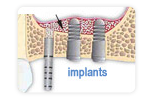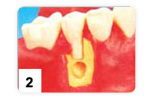
More information
Diagnosis
Each implant is individually adjusted, shaped and sized to suit the conditions in the patient's mouth. Therefore the planning of treatment includes X-ray photos (panoramic) and often computer tomography.

Surgical operation

During the operation, the place in the bone, where the implant is to be inserted, is being prepared, and the place above the implants is sutured. The surgery is carried out in local anaesthesia, and is totally painless. In justified cases it can be carried out under total anaesthesia. The operation lasts approximately one hour. Slight aches and minor swelling are the only discomforts, lasting about one week, after which the stitches are removed. During this period the patients remain under constant care of our practice. The period of full integration of implants with the bone structure takes 3 to 6 months. After that period, prosthetic restoration follows (fixing the teeth – usually made of porcelain).
Cosmetics in implant treatment? Yes!
The correct placement of the implant is not sufficient to achieve the optimal cosmetic effect. Especially in case of front teeth, the so-called soft tissue management is of primary importance. In such cases, GTR techniques are use.
Direct
is a one-piece implant with unique features. Thanks to the so-called flapless procedure the dentist does not even cut the gingiva. The whole process does not require a scalpel, needles and stitches. The healing of gingiva is very quick, the patient avoids swelling and pain after the operation. This process can be used only with favourable anatomic conditions.
When the space for an implant is lacking
In such cases we use guided bone regeneration techniques (GBR). These operations extend the course of treatment, but they are often the only way to successful treatment.
Guided Bone Regeneration
With the use of BioOss® and BioGide® bone-inducing and bone replacement preparations and membranes (BioGide, BioCollagen), it is possible to restore tooth-supporting structures – restoration of bones destroyed by parodontosis, bone restoration before implant placement.
When do we use GBR?
- Periodontopathy
This damage is caused by bacteria existing in the plaque. Its aggregates cause damage of supporting tissues; the tissue supporting the tooth disappears, and the ligament with its surrounding bone are destroyed, resulting in tooth loss. - Apex changes
This effect is caused by inflammation around the tip of the root. Such inflammation causes destruction of bone structure. - Extractions
Empty tooth socket after tooth extraction must be filled with bone-inducing granulate to avoid atrophy of the alveolus. - Implant treatment
- when the amount of patient's own bone is insufficient for the introduction of an implant;
- when the insufficient bone amount does not cover the visible thread of the implant;
- when the alveolus is too narrow;
- when the height of the alveolus is to small.
- Augmentation
Bone-inducing particles are placed in the bone loss. - Covering with membrane
Holds the preparation in place and allows for proper bone reconstruction. - Sinus floor elevation
Also called sinus-lifting – thickening of the bottom wall of the sinus, where the implant is to be placed (in the side part of the maxilla).



GTR-guide tisscue regeneration
In case of missing teeth, an atrophy of surrounding tissues (gingiva and tooth-surrounding bone) occurs. The more time has elapsed since the tooth was lost, the larger the atrophy. Therefore, when replacing the missing tooth with an implant we must also rebuild the tissues which surrounded it in the past. Particular stages of treatment may last from 3 to 12 months, depending on the degree of gingival recession. We use bone replacement preparations, membranes and sometimes gingival transplants. The whole process is called soft tissue management.
Contraindications
There is a group of patients, whom we cannot help using implant techniques (due to general diseases or anatomic conditions in the oral cavity). However, we are always able to offer an alternative solution based on conventional prosthetics.
All the conditions, treatment methods and prognosis are discussed with the patient by the implantologist at a consultation visit after detailed examination.
Costs of implant treatment
Treatment costs depend on the amount and scope of operations carried out (including preparatory operations such as (GBR). Also the type of denture made affects the final cost of treatment. Surgical insertion of one implant costs about 3000 PLN.
In order to get acquainted with the possibilities and costs of implant treatment, feel free to visit us (the cost of a consultation visit is 50 PLN).
Whenever possible, implant treatment should be the treatment of choice. It is the most effective solution to the problem of missing teeth and saves the adjacent other teeth to the largest extent.
Dear Patient!
Remember that we accept payments by instalments.





